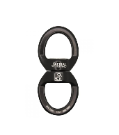By Olivia Egerstedt
Note: Aerial rigging should only ever be done by a qualified, trained, and experienced professional. This article is only for educational purposes and to inform about the basics of checking rigging, and is NOT everything that is needed for safe rigging. If you want to learn more about the dangers of rigging as a beginner I encourage you to check out this article: 10 Good Reasons Why New Aerialists Should Think Carefully Before Rigging
Safe rigging is essential to ensure aerialists stay safe in the air. While rigging should be done only by someone trained in rigging, it’s important for all aerialists to understand their equipment, basic rigging, and how often equipment should be checked and inspected.
Basic rigging should be checked monthly and full rig inspections should be done by a professional.
Carabiners:
There are many types of carabiners. The two most common are auto-lock gate, which twists shut automatically when closed, and screw gate, which must be screwed down in order to prevent them from opening on their own. Carabiners with screw gates must be flipped so the gate locks downward, so they don’t become unscrewed for gravity. An easy way to remember this is by using the expression “screw down, so you don’t screw up!” Carabiners with auto-locking gates won’t open when the gate opens upward, but it can be useful to orient them the same way as screw-gate carabiners for consistency and easy visual inspection if both kinds are being used.
Some carabiners have a wider side and a thinner one. The wider side often will be the side that should be facing down and should be connected to the thicker part of the rigging, for example, if you are rigging to a span set or eye on a trapeze, rope, etc.
You should also avoid tri-loading your carabiners. Tri-loading is where you have three forces pulling the rigging in different directions (including the top). Tri-loading can happen with a double-point Lyra or straps. To avoid tri-loading, you should use a bear claw or separator.
Swivels:
Swivels are the weakest part of a rig and are the most likely to fail. This can be hard to test but there are ways to tell when a swivel is about to give out. The most common sign of a swivel failing is a clicking sound when spinning. You can also feel the swivel sticking and having a harder time rotating. If you find that the swivel is acting differently, retire and replace it IMMEDIATELY.
All Metal Equipment:
Carabiners, figure 8s, and swivels can be made of different materials, the most common are steel and aluminum. Aluminum is a softer and lighter metal than steel and when these two are linked to each other in rigging, wear can happen quicker than it would if you only used one type of metal (such as all aluminum or all steel.) Whatever metals you have, the configuration needs to be checked monthly for wear and erosion. You can check this by using a Caliper micrometer, which you can get at your nearest hardware store. When a carabiner, figure 8, or swivel has reached 10% wear (meaning 10% of the width of the equipment has worn off), it is time to retire and replace that equipment.
Fabric:
You should be checking your fabric regularly for rips or tears and if it’s in the sun, watch for sun damage that could weaken the strength of your fabric. There are two directions rips could be, horizontal (side to side) and vertical (up and down). Horizontal tears are much more concerning than vertical because as they spread they start cutting off the bottom of the silks. If you find a horizontal rip, you should replace those silks or cut above the tear and turn them into shorter silks or a hammock. Vertical tears aren’t as dangerous and should be monitored to make sure they aren’t getting bigger. You can do this by drawing a circle around the hole and if the rip stays inside the circle it’s ok, but if it begins to spread you need to replace your fabric. Either way, if a tear is more than an inch or two, the equipment should be taken down and retired.
You can prevent holes in your fabrics by not wearing zippers, sequins, jewelry, or anything else that could catch, poke through, or tear the equipment.
You should also check and make sure you can always see the ears on your figure 8 and that the fabric is not covering them. Otherwise, the fabric can stretch out and rip.
Equipment wears and shifts with time and use. If you feel uncertain about the rigging or if anything looks unusual or strange, ask questions and stay off the equipment until it’s checked.


